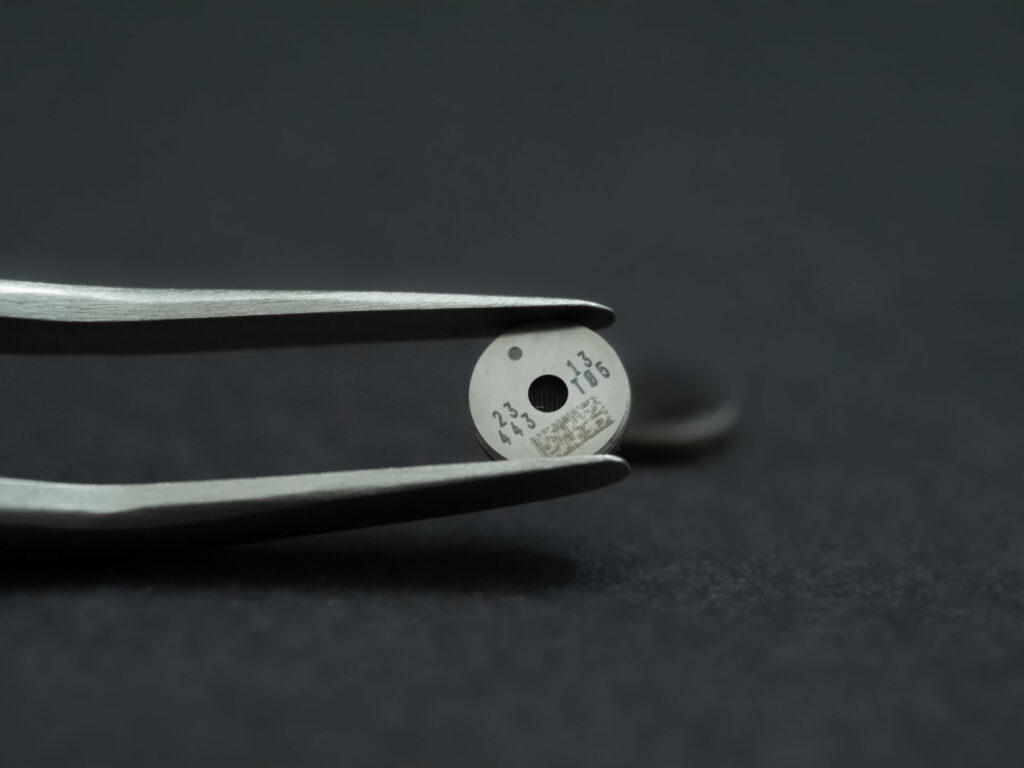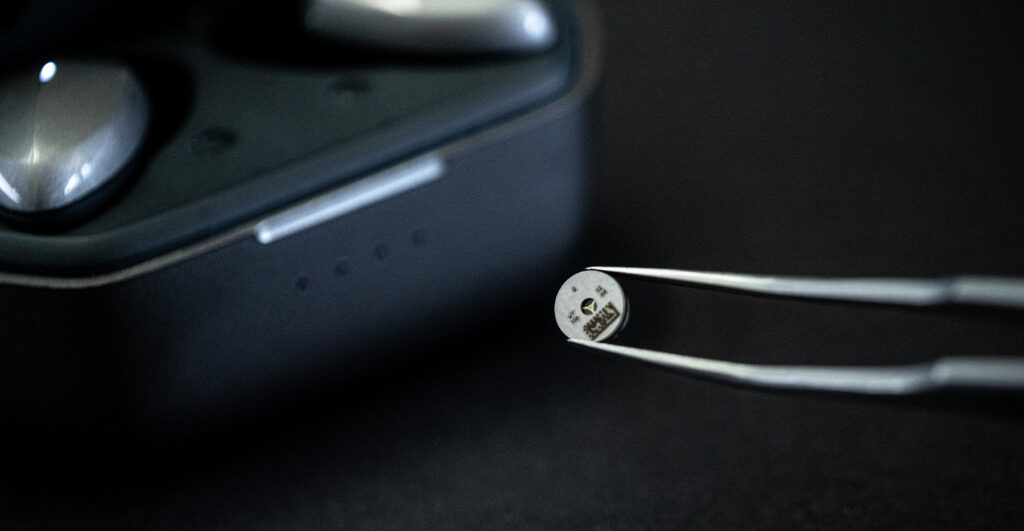What are “IEMs,” and how can they benefit from MEMS speakers?
In-ear monitors have become an essential device for musicians, performers, and audiophiles. As their intended users are audio professionals, these tiny in-ear devices require unparalleled audio performance and the most accurate sound reproduction. That is why IEM designers have already started showing interest in MEMS speakers, which provide the best audio performance in the smallest form available on the market.
What Are In-Ear Monitors?
In-ear monitors (IEMs) are a special type of earphone device used by musicians, audiophiles, performers, and audio engineers for activities that require delivering high-quality sound directly into the ears. They were originally developed for musicians to be able to hear themselves and each other on stage without relying on traditional stage monitor speakers. Around 10 years ago, the consumer audience for IEMs widened to include audiophiles and everyday listeners. As a consequence, today, in the audiophile scene, the term “IEM” refers to high-end earphones (usually wired) with certain audio quality characteristics.
Unlike regular earbuds or headphones, IEMs are designed to fit snugly into the ear canal, providing superior noise isolation and detailed audio reproduction. They often have a flatter frequency response in comparison to common earphones, as their typical users prefer a neutral sound that remains as faithful as possible to the original audio source. Regular earphones tend to “colour” the sound in multiple ways, such as by giving emphasis on the bass or the highs. Audiophiles, musicians, and non-professional listeners choose IEMs due to the need for a more accurate sound reproduction, powerful output level, superior noise isolation, and their peculiar wearing style (e.g., “cable over the ear” rather than the usual “cable straight down”).

Key Features of In-Ear Monitors
IEMs are renowned for their sound quality, offering clear and accurate audio reproduction across a wide frequency range. This is essential for musicians and sound engineers who need precise audio monitoring.
Moreover, IEMs provide a superior passive noise isolation by creating a seal between the ear canal and the surrounding environment. This helps block out external noise, making IEMs ideal for noisy environments like live concerts or studios. Furthermore, most IEMs are custom moulded to fit the unique shape of an individual’s ear. This not only enhances comfort but also significantly improves the sound quality. Professional IEMs are also very robust, as they are built to withstand harsh environments, potential drops, and frequent use (e.g., on a stage during a live performance).
Applications
In-ear monitors have recently gained popularity in various fields, due to their unparalleled sound quality and portability. Here are some of the main applications of IEMs:
Live Performances
- IEMs allow musicians and vocalists to hear a clear and precise mix of their own performance along with the rest of the band or with backing tracks. This helps them stay in sync and maintain pitch and timing accuracy, and overall performance quality.
TV and Radio
- Journalists in the field often use IEMs to hear questions and cues from the studio, ensuring smooth and coordinated live reports.
Audiophiles, Gaming and Everyday Listening
- Audiophiles use IEMs for their ability to deliver detailed, clear, and immersive sound. Gamers use IEMs to experience an immersive audio experience, benefitting from their detailed soundstage and clarity, which can enhance the gameplay.
- For everyday listening, IEMs offer a portable and high-quality audio solution, making them a popular choice for commuters and travellers, due to their superior noise isolation.
Hearing Protection
- IEMs can be used to double the hearing protection in very loud environments, such as construction sites.
- Thanks to their superior noise isolation, IEMs allow users to listen to audio at lower volumes than traditional earbuds, protecting their hearing from long-term damage.
Fitness and Sports
- Several sport and fitness enthusiasts use IEMs during their workouts. The secure fit together with the robust and sweat-resistant design make them ideal for outdoor use.
- Some professional athletes use IEMs during training to receive real-time feedback and instructions from coaches.
Choosing the Right IEM
Consumers consider multiple factors before choosing an IEM design, with the main ones being the following:
- Driver type: the choice between electro-dynamic, balanced-armature, MEMS or hybrid configurations will affect the overall sound characteristics and lead to different audio profiles (e.g. bass-heavy, neutral, bright, etc). For example, MEMS speakers provide IEMs with superior sound clarity and definition.
- Fit and comfort: a good fit must be ensured for prolonged use to avoid discomfort.
- Budget: based on the specific design (type and number of drivers, materials used, additional sensors, accessories), the corresponding price might range from affordable options to very expensive high-end custom models.
How to Design In-Ear Monitors
Designing IEMs involves a combination of acoustic engineering, material science, and product design skills. In order to create the most competitive IEMs on the market, IEM designers need to take the following into consideration:
Define Targets and Requirements:
The designer should first identify the target user for the IEMs. Does the target audience include musicians, audiophiles, gamers, or general consumers? Based on this, the desired IEM sound will be identified (for more information, you can check our article on how headphones should sound). The expected audience will also determine whether to go for universal-fit or custom-moulded IEMs.
Acoustic Design
Once the audio targets and requirements have been defined, the next step is the design of the actual acoustic layout, which requires making three main decisions:
Driver type selection: One of the key components of the IEM is the driver (the speaker). In the past, IEMs typically used traditional electrodynamic and balanced-armature speakers. Today, IEMs can benefit from an innovative audio solution: the Micro-Electro-Mechanical Systems (MEMS) speaker.
Thanks to their compact form factor and integration flexibility, MEMS speakers are the ideal component for small devices, such as wireless earphones and IEMs. MEMS speakers present an above-class audio performance in the mid-to-high audio range, making them the ideal tweeters for IEMs. Moreover, they require a higher input voltage compared to the bulkier, traditional speakers, which is easily managed with the use of an external amplifier. USound has already launched the Tarvos 1.0 ASIC linear amplifier to drive MEMS speakers, which reaches sub-mA quiescent current consumption.
Additionally, MEMS speakers are recognized for their high precision and consistency in manufacturing, great reliability, robust construction, fast transient response and superior high-frequency response, which makes them ideal for applications that require detailed sound reproduction in the whole audio range and at ultrasound frequencies.
Single-driver vs. multi-driver layout: While a single-driver system features only one speaker of a specific type to cover the whole frequency band of interest, a multi-driver layout includes two or more speakers. Several IEMs on the market feature more than 10 units per earbud, belonging to the same type or different technologies, in order to achieve a higher clarity in the frequency range. The latter is called a “hybrid setup”. USound MEMS tweeters are an ideal choice in multi-driver setups, along with traditional drivers used for the low-end sound reproduction.
Crossover design: In the case of a multi-driver layout, the speakers can either coexist altogether, overlaying their audio performance, or they can be driven by crossovers of various complexity and characteristics. The main purpose is to segment the audio range into smaller frequency bands, each controlled by a crossover, for a more defined and comprehensive audio performance. For advanced designs, digital signal processing (DSP) is used to manage the crossover frequencies more precisely.
Wiring
Most IEMs are wired, whereas headphones and earbuds are commonly offered as wired or wireless variants (TWS). This allow IEMs to be equipped with very powerful and high-performance drivers without worrying too much about power consumption. Also, a wired earphone allows for a lower system latency, which is a crucial factor in live-music performances.
Ear Tips
This is one of the most overlooked and underestimated features of an IEM (and earphones in general). Ear tips shape and design influence the acoustic performance of the earphones, thus representing a key factor in earphone design. The ear tips are available in two different fittings:
- Universal fit: silicone or foam ear tips in various sizes to accommodate standard ear shapes and sizes.
- Custom fit: High-end IEMs usually offer custom-moulded tips based on the actual user’s ear shape. They offer better sealing and comfort, and a greater isolation from ambient noise, at the expense of a higher cost.
The sealing achieved with the ear tip is essential to achieve an optimal low-end audio quality. IEMs are specifically designed to achieve optimal in-ear sealing. On the other hand, wearing traditional earphones might cause some degree of leakage (e.g., a tiny air gap between the ear tip and the ear canal, leading to some sound escaping into the outside environment). To compensate for this, USound experts provide customers with specific acoustic design techniques that reduce leakage and provide an adequate level of bass frequencies.
New frontiers for IEMs development: MEMS speakers
The use of MEMS speakers in earphones is a promising area of development, quickly expanding in the audio products market. The benefits of using MEMS speakers specifically for IEMs include:
- Enhanced Audio Performance: thanks to their inherent characteristics MEMS speakers deliver exceptional audio performance, exceeding market demands.
- Customization: the tiny form factor of MEMS technology, together with their simple design and driving requirements, allow for personalized audio experiences, with IEMs tailored to individual hearing profiles.
- Robust design: thanks to their inherent mechanical features, USound MEMS speakers are ideal for high-end IEMs, which can withstand harsh indoor and outdoor environments.
USound MEMS speakers are the ideal choice for the design of IEMs, thanks to their ultra-compact size, high precision and consistency, superior acoustic performance, and innovative design. These benefits make USound MEMS speakers an attractive choice for a wide range of applications in addition to IEMs, such as true wireless systems (TWS) and over-the-counter (OTC) hearing aids.

MEMS-based IEMs on the Market
USound has been selected by Soranik – a leading manufacturer of audiophile in-ear monitors – as a MEMS-speaker supplier for their next-generation IEM design. The “MEMS-2” and “MEMS-3” IEM models by Soranik are already available on the market.
Are you looking for the ideal speaker for your IEM design? Contact our team of experts and learn more about our MEMS technology.

About the Author
Andrea Greco is a Field Application Engineer at USound. He has international experience as an Acoustics Engineer, with a background in both acoustics and music. LinkedIn


